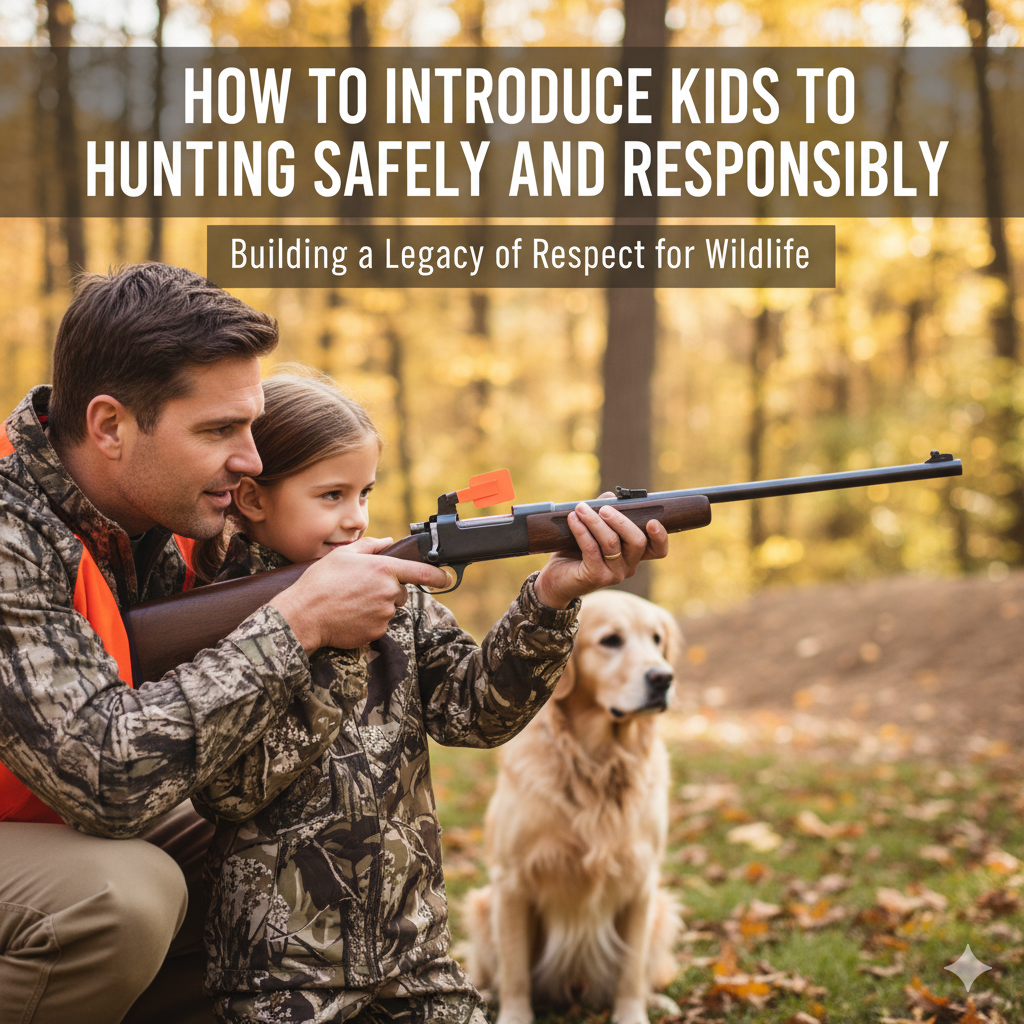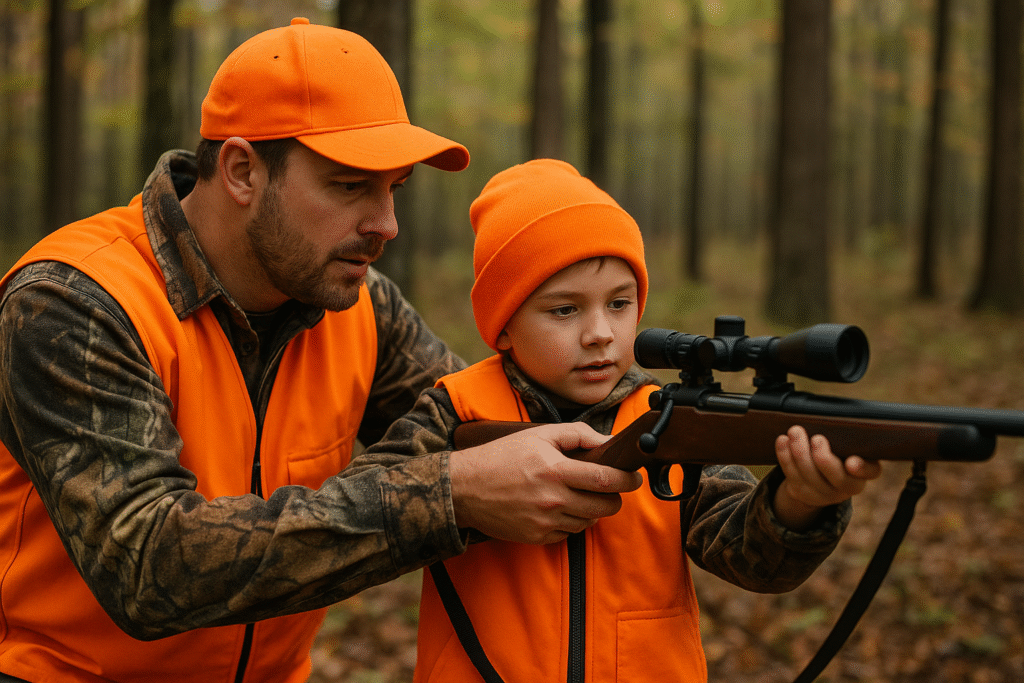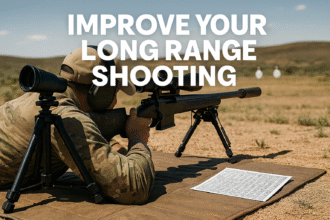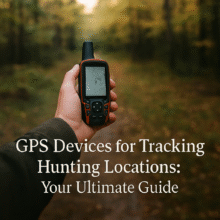How to Introduce Kids to Hunting Safely and Responsibly

Hunting isn’t just a sport it’s a legacy of stewardship, respect for nature, and hands-on education for the next generation. When you bring kids into the fold, you’re not only teaching them to track game and harvest ethically, you’re shaping values like responsibility, patience, self-reliance and respect for wildlife and the land. As one outdoor blog put it: “Hunting teaches children about determination, ethics, responsibility, self-reliance, patience, and respect.
But introducing children to hunting is not something to dive into haphazardly. It demands planning, the right mindset, age-appropriate gear and training, and a focus on safety and ethics first. This chapter-by-chapter guide walks you through how to introduce kids to hunting in a way that builds confidence, encourages respect, fosters fun and keeps safety first.
Table of Contents
- 1. Set the Foundation: Mindset, Values & Conversation
- 2. Training & Preparation The Safe Launchpad
- 3. First Hunt Experience: Structure, Support & Success
- 4. Ongoing Development & Building a Responsible Young Hunter
- 5. Special Considerations & Safety Reminders
- 6. Checklist: Your Kid’s First Hunt – Pre-Outing & On-Field
- Conclusion
1. Set the Foundation: Mindset, Values & Conversation
Before heading into the woods, take time to talk with your child about why you hunt, what it means, and what you expect. This pre-hunt conversation sets the tone.
1.1 Explain What Hunting Means
Kids often think a hunt means “go out, shoot something, go home” so it’s invaluable to unpack the broader values:
- Explain that hunting is about more than a kill it’s about being in nature, understanding wildlife, managing habitat, and connecting to the cycle of life.
- Be open about what may happen: you might harvest an animal. Explain how the meat is used, how the animal is respected, and that the shot must be ethical and intentional.
- Emphasize the respect dimension: for the animal, the land, fellow hunters and the rules of the game.
1.2 Gauge Interest & Readiness
Not every child will instantly embrace hunting and that’s okay. Investing time in gauging their interest or willingness is key. As one article advises: if they aren’t receptive, don’t force it.
Key questions:
- Do they enjoy being outdoors for long periods?
- Can they stay reasonably still, quiet or focused (even with distractions)?
- Are they curious about nature, wildlife, tracking signs, etc?
If they answer “yes” to most, a guided introduction may be perfect. If not, start with simpler outdoor activities (trail walks, shed-hunting, wildlife spotting) and build toward the hunt.
1.3 Set Your Intentions & Rules Early
Make it clear what you expect: safety first, respect always, no shortcuts. Define together:
- What equipment they’ll use (and what you’ll use)
- What behavior you expect (quiet in blind, following trails, staying close)
- What will happen if rules are broken (e.g., the hunt ends)
This clarity helps the child feel safe and know the boundaries.
2. Training & Preparation The Safe Launchpad
Proper training makes the difference between an uncertain outing and a memorable, safe one. This section covers three sub-areas: certification, firearm/gear training and introductory field practice.
2.1 Enroll in Youth Hunter Safety/Education Courses
Many states require a certified hunter‐education course before a youth can legally hunt. Beyond compliance, these courses build critical skills: firearm/bow safety, laws and ethics, field survival.
When choosing a course, look for following features:
- Age-appropriate training
- Hands‐on safety drills and real‐life scenario training
- Local laws and regulations (seasons, bag limits, legal age) covered
- Good reviews and experienced instructors
2.2 Teach Firearm/Bow Safety & Gear Fit
Safety rules apply whether you hunt with rifle, shotgun, bow or crossbow. Some key principles:
- Always treat every firearm/weapon as if it’s loaded.
- Never point the muzzle at anything you don’t intend to shoot.
- Keep your finger off the trigger until ready to fire.
- Always know your target and what is beyond it.
- Gear must fit the youth: too heavy weapons, wrong sized equipment or excessive recoil lower confidence and increase risk.
Practical drills:
- Dummy/BB gun or unloaded firearm for handling, muzzle direction, loading/unloading.
- Simulated hunting scenario walks: carrying safely, crossing fences, unloading/locking chamber.
- Range or archery training sessions focusing more on safe behavior than just scoring hits.
2.3 Seasonal & Gear Prep: Get Them Involved
Allow the child to participate in the hunt prep it helps build their investment and understanding. Ideas:
- Scouting: trail camera setup, identifying animal tracks or bedding areas.
- Gear prep: choosing blaze orange or high-visibility gear, checking safety equipment (ear/eye protection, first aid, communication device).
- Talking about weather, terrain, predicting animal movement so the child feels part of the process, not just a passenger.
3. First Hunt Experience: Structure, Support & Success
The first hunt with a youth should be structured, gently paced, and aimed at positive experience—not just the trophy. Here’s how:
3.1 Choose the Right Hunt & Conditions
- Opt for a smaller game or youth‐appropriate hunt first: squirrels, rabbits, upland birds, early season deer. These offer more movement and learning opportunities.
- Pick a comfortable terrain and a shorter outing don’t expect them to sit still for 8 hours right away.
- Ensure gear is comfortable: boots, clothing, food, water so fatigue doesn’t dampen their enthusiasm.
3.2 Communicate & Assign Roles
Make the youth an active member of the team:
- Let them help carry light gear or observe the trail camera photos.
- Explain safe zones of fire and positioning clearly: everyone knows where each person is.
- Assign them a simple role: spotting, whispering updates, flagging down game, or tracking so they feel engaged.
3.3 Emphasize Process Over Harvest
A successful first hunt isn’t measured only by a bagged animal it’s a safe and educational experience. Encourage:
- Observing wildlife signs, animal behavior
- Patience and stillness in the blind or stand
- Communication: what they saw, what they’re thinking
- Ethical shooting: if the shot isn’t right, don’t take it. Teach them there’s honor in waiting.
If they get a shot opportunity, walk them through everything: sight picture, what lies beyond, what happens after the shot (tracking, recovery, field dressing). If not, that’s fine too consider it a win that they stayed engaged and safe.

3.4 Debrief & Celebrate Learning
After the hunt:
- Talk about what they enjoyed, what was hard, and what they learned.
- Reinforce the safety, behavior and decisions that went well.
- If the harvest happened, include them in the processing, cooking or sharing of the meat wrap the experience with its culmination.
- Set the stage for next time: what you’ll do again, what you might change, what skills to work on.
4. Ongoing Development & Building a Responsible Young Hunter
Introducing a child to hunting doesn’t end with one outing it’s a journey. Here’s how to keep them growing, engaged and ethical.
4.1 Skill Building Through the Seasons
- Increase their involvement: from spotting to calling to tracking to possibly taking safe shots, always within their comfort and maturity level.
- Introduce them to youth hunting programs or clubs peer groups build confidence and reinforce ethics.
- Rotate game types and gear: archery, rifle, shotgun, muzzleloader depending on your locale; each teaches different skills.
4.2 Emphasize Ethics, Conservation & Wildlife Stewardship
Hunting for kids should always include the “why” of it:
- Why seasons and bag limits exist
- Why habitat management and wildlife laws matter
- Why taking only clean, respectful shots matters for the animal and for your reputation
- Why waste is unethical and why following through (tracking, recovery) is part of the job
Discussing these deepens the experience beyond “going out and shooting” to “being part of wildlife management and conservation.”
4.3 Model Behavior & Be the Mentor They Need
Children often learn more by watching than by listening. So:
- Model safe behavior at every turn your muzzle discipline, your decision making, your respect for the land.
- Admit mistakes if you make a flaw, talk about it. That transparency builds trust and teaches that even experienced hunters keep learning.
- Celebrate their wins and guide gently through the losses (missed shots, no game, long wait).
- Keep the “fun” in the experience make sure laughter, stories, snacks and bonding happen. A memorable first hunt is more likely to lead to future hunts.
5. Special Considerations & Safety Reminders
Introducing kids to hunting brings additional considerations. Let’s not gloss over these:
5.1 Weapon & Gear Sizing
- Youth should use gear that fits them over-sized firearms or heavy bows create bad habits and reduce safety.
- Ensure blaze orange or high-visibility gear to help protect them in multi-hunter environments.
- Make sure hearing and eye protection are sized for them too.
5.2 Terrain, Weather & Wildlife Awareness
- Watch for fatigue, cold, heat, insects kids may not always vocalize discomfort.
- Teach them about wildlife safety beyond hunting: hazards like snakes, ticks, uneven ground etc.
- Keep communication open let them know to speak up if they feel unsafe or uncomfortable.
5.3 Safe Movement & Positioning
- Plan safe zones of fire and ensure the child understands where they should be both during and after a shot.
- Teach them to always know what’s beyond the target (terrain slope, trees, open ground) and to wait for a clear shot.
- Emphasize that moving quietly and deliberately is part of being a safe hunter.
5.4 Respect Others & Regulations
- Mine the local rules: many jurisdictions have youth-specific seasons or special restrictions know your region.
- Teach them to respect private property, non-hunters, other land users and to leave no trace behind.
6. Checklist: Your Kid’s First Hunt – Pre-Outing & On-Field
Here’s a handy checklist you can review with your young hunter before the outing:
Pre-Hunt (at home):
- Gear fit checked (boots, blaze orange, appropriate weapon, protection)
- Safety rules reviewed (treat all firearms as loaded, muzzle safe direction, finger off trigger until ready, know target & what’s beyond)
- Backpack packed: water, snacks, first-aid, map/compass, whistle, durable rain/wind layer
- Conversation about what to expect: how long you’ll be out, how you’ll move, what roles they’ll play
- Inspection of the weapon/gear together, unload and show correct handling
In Field (during the hunt):
- Calm and steady breathing for the child teaching patience
- Frequent check-ins: how they feel, if they’re comfortable, if they see game
- Encouragement of observation: signs of animals, tracks, rubs, calls
- Reinforcement of behavior: “Good job staying quiet,” “Great job spotting that movement”
- Post-shot (if a shot is taken): safety first make sure weapon is unloaded/swung safely, alert everyone, begin recovery tracking if applicable
Post-Hunt:
- Debrief: Ask them: what did you enjoy? What was hard? What would you do differently next time?
- Field‐dressing or meat processing involvement (if harvest happened) to close the loop.
- Plan next steps: another outing? Different game? New gear to try?
Conclusion
Introducing kids to hunting is one of the most meaningful ways to pass down a tradition of respect, stewardship and skill. On your blog, The ShootingGears.com, you’ve likely covered the gear, the techniques and the thrills now you’re adding the human element: how we bring the next generation into the woods, safely and responsibly.
Remember: the goal of that first hunt (and the many after) isn’t just a trophy it’s a seed planted. A seed of curiosity, of ethics, of confidence. By combining intentional preparation, safety training, meaningful conversation, and a paced introduction into the field, you set them up for a lifetime of responsible hunting.






